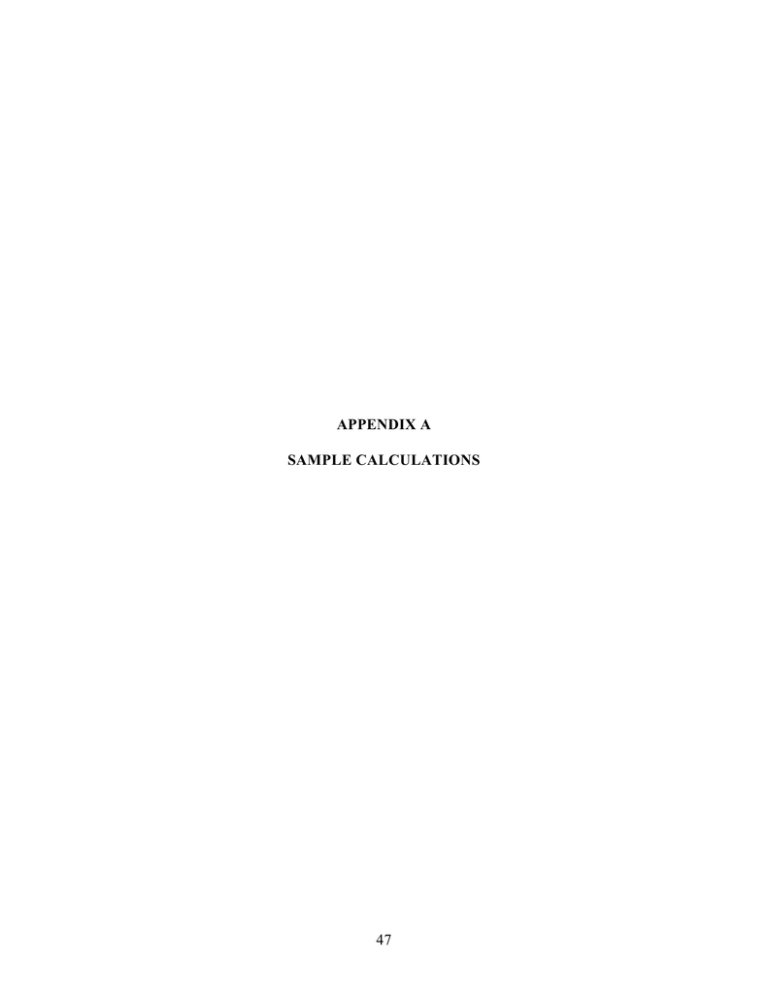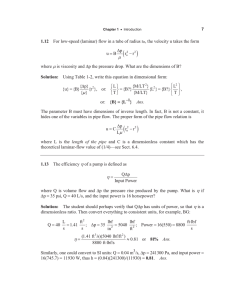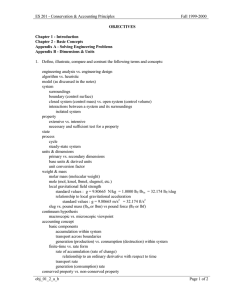47 APPENDIX A SAMPLE CALCULATIONS
advertisement

APPENDIX A SAMPLE CALCULATIONS 47 Example Calculation of Predicted Natural Frequency Given: Calculate: Spring constant, k = 395 lb/in. Effective Vertical Floor Mass Weight = Weff, vert Weff, vert = Wblocks + Wslab Weff , vert = 9(60 lb) + 150 lb ft 3 (12 ft )(12 ft ) 55. in.12 Weff, vert = 3015 lb in. ft 1 air spring 4 total air springs m = Weff, vert / g Predicted Natural Frequency = fn,pred 1 k f n , pred = m 2π 1 395 lb in. f n , pred = 2π 3015 lb 386.4 in. s2 fn, pred = 1.13 hz Example Calculation of Predicted Natural Frequency for Corner Rotation Mode of Oscillation (Approximate Method) Given: Axis of rotation illustrated in Figure 2.7 and discussion of Equations (2.2)(2.4) in Chapter 2. Calculate: wLs 2 Weff ,vert = Wb + 2 Wb = 9(60 lb.) = 540 lb 55 . in. w = 150 lb ft 3 in. = 68.75 psf 12 ft Ls = 12.0 ft (68.75 psf )(12.0 ft ) 2 Weff , vert = 540 lb + Weff , vert = 5490 lb 2 L Weff ,rotate = Wb + wL ∫ y 2 dx 0 48 x = modal displacement of effective section αL x = distance from axis of rotation to spring location (corner of slab) α =(distance from axis of rotation to air spring) / (length of effective section) L = length of effective section L 2 x Weff ,rotate = Wb + wL ∫ dx αL 0 y= L 3 wL2 wL x Weff ,rotate = Wb + 2 2 = Wb + 2 3α α L 3 0 94 in. α = = 0.922 102 in. L = 8.5 ft (68.75 psf )(8.5 ft ) 2 Weff , rotate = 540 lb + 3 (0.922) 2 Weff , rotate = 2488 lb f n ,rotate = f n ,vert Weff ,vert Weff ,rotate f n , vert = 113 . hz f n , rotate = (113 . hz ) 5490 lb 2488 lb f n , rotate = 168 . hz Example Calculation of Predicted Natural Frequency for Side Rotation Mode of Oscillation (Approximate Method) Given: Axis of rotation illustrated in Figure 2.8 and discussion of equations (2.2)(2.4) in Chapter 2. Calculate: Weff ,vert = Wb + wLs 2 Wb = 9(60 lb) = 540 lb 55 . in. w = 150 lb ft 3 in. = 68.75 psf 12 ft Ls = 6.0 ft Weff , vert = 540 lb + (68.75 psf )(6.0 ft ) Weff , vert = 3015 lb 2 49 L Weff ,rotate = Wb + wL ∫ y 2 dx 0 x y= αL x = distance from axis of rotation to spring location (side of slab) α=(distance from axis of rotation to air spring) / (length of effective section) L = length of effective section L 2 x Weff ,rotate = Wb + wL ∫ dx αL 0 L 3 wL2 wL x Weff ,rotate = Wb + 2 2 = Wb + 2 3α α L 3 0 65 in. α = = 0.903 72 in. L = 6.0 ft (68.75 psf )(6.0 ft ) 2 Weff , rotate = 540 lb + 3 (0.922) 2 Weff , rotate = 1552 lb f n ,rotate = f n ,vert Weff ,vert Weff ,rotate f n , vert = 113 . hz f n , rotate = (113 . hz ) 3015 lb 1552 lb f n , rotate = 157 . hz Example Calculation of Predicted Natural Frequency for Corner Rotation Mode of Oscillation (Exact Method) Given: Calculate: Axis of rotation illustrated in Figure 2.7 and Equations (2.5) - (2.9) in Chapter 2. Using the parallel axis theorem, calculate the mass moment of inertia of the blocks added to the corner of the floor slab: I blocks = I + md 2 I = 0 (relative to total Iblocks) 2 (9) (60 lb) lb - s2 m = = 33.54 32.2 ft s2 ft 50 9.9 in. = 7.66 ft 12 in. ft lb - s2 (7.66 ft )2 = 33.54 ft = 1968 lb - ft - s2 d = 8.485 ft I blocks I blocks I slab = I + md 2 d = 0 (slab rotates about centroidal axis) I slab = ∫y 2 dm = ρ t ∫y 2 dA = ρ t I x 1 s2 ft 3 32.2 ft 5.5 in. t = = 0.458 ft 12 in. ft 1 Ix = bh 3 12 1 I x = 2 (2)(8.485 ft)(8.485 ft) 3 = 1728 ft 4 12 ρ = 150 lb ( ) 1 s2 I slab = 150 lb 3 (0.458 ft )(1728 ft 4 ) ft 32.2 ft I slab = 3689 lb - ft - s2 I total = I blocks + I slab = (1968 + 3689) lb - ft - s2 Itotal = 5657 lb - ft - s2 M = 2 k (d)(d) Θ M = 2 395 lb ( )( ) 7.66 ft x 12 in. ft (7.66 ft ) Θ in.3 M = 566,244.7 Θ (lb - ft) Substitute into Equation (2.5): M + I (d2Θ/dt2) = 0 566,244.7 Θ + 5657 d2Θ/dt2 = 0 ω = f n , rotate f n , rotate 2 k d2 566,244.7 lb - ft = = 9.92 rad s I 5657 lb - ft - s2 1 1 = ω = 9.92 rad s 2π 2π = 1.58 hz ( ) 51 Example Calculation of Predicted Natural Frequency for Side Rotation Mode of Oscillation (Exact Method) Given: Calculate: Axis of rotation illustrated in Figure and Equations (2.5) - (2.9) in Chapter 2. Using the parallel axis theorem, calculate the mass moment of inertia of the blocks added to the side of the floor slab: I blocks = I + md 2 I = 0 (relative to total Iblocks) 4 (9) (60 lb) lb - s2 m = = 67.08 32.2 ft s2 ft 7.0 in. d = 6.0 ft = 5.42 ft 12 in. ft lb - s2 (5.42 ft )2 I blocks = 67.08 ft I blocks = 1968 lb - ft - s2 I slab = I + md 2 d = 0 (slab rotates about centroidal axis) I slab = ∫y 2 ρ = 150 lb dm = ρ t ft 3 ∫y 2 dA = ρ t I x 1 s2 32.2 ft 5.5 in. = 0.458 ft 12 in. ft 1 Ix = bh 3 12 1 (12 ft)(12 ft)3 = 1728 ft 4 Ix = 12 1 s2 I slab = 150 lb 3 (0.458 ft )(1728 ft 4 ) ft 32.2 ft t = ( ) I slab = 3689 lb - ft - s2 I total = I blocks + I slab = (1968 + 3689) lb - ft - s2 52 Itotal = 5657 lb - ft - s2 M = 4 k (d)(d) Θ M = 4 395 lb ( )( ) 5.42 ft x 12 in. ft (5.42 ft) Θ in.3 M = 566,292.7 Θ (lb - ft) Substitute into Equation (2.5): M + I (d2Θ/dt2) = 0 566,292.7 Θ + 5657 d2Θ/dt2 = 0 2 k d2 566,292.7 lb - ft = = 9.92 rad s I 5657 lb - ft - s2 1 1 = ω = 9.92 rad s 2π 2π = 1.58 hz ω = ( f n , rotate f n , rotate ) Example Calculation of Measured Acceleration Response Given: Frequency spectrum of acceleration response due to jumping at 1.5 hz Valve Configuration = None Frequency Spectrum Jumping @ 1.5 Hz - F0204A1 150 5.00 4.00 3.00 2.00 1.00 0.00 -1.00 -2.00 -3.00 -4.00 -5.00 Magnitude Acceleration (%g) Acceleration vs. Time Jumping @ 1.5 Hz - F0204A1 100 50 0 0 4 8 12 16 0 2 4 6 Frequency (Hz) Time (sec) Measured Input Average Peak Acceleration = 2.24 %g Magnitude of Frequency Spectrum at First Harmonic = 113.14 Magnitude of Frequency Spectrum at Second Harmonic = 16.32 Magnitude of Frequency Spectrum at Third Harmonic = 14.81 Calculate: Ratio of Frequency Spectrum Magnitudes 53 8 10 Second / First Harmonic = 16.32 / 113.14 = 0.14 Third / First Harmonic = 14.81 / 113.14 = 0.13 Measured Input Average Peak Acceleration at Second Harmonic = (2.24 %g) x (0.14) = 0.32 %g Measured Input Average Peak Acceleration at Third Harmonic = (2.24 %g) x (0.13) = 0.29 %g Example Calculation of Measured Force Transmission Given: Frequency response of measured input and output force response due to jumping at 1.5 hz Valve Configuration = None Output Force vs. Time Jumping @ 1.5 Hz - F0204F1 Frequency Spectrum Jumping @ 1.5 Hz - F0204F1 15000 3180 Magnitude Output Force (lbf) 3200 3160 3140 10000 5000 3120 3100 0 0 4 8 12 16 0 2 4 6 8 10 Frequency (Hz) Time (sec) Input force initial force plate reading = 205.7 lb Output force initial force plate reading = 3161.6 lb The following charts show the peak negative (-) and positive (+) readings from the input and output force response plots minus initial force plate reading The average impact value is the average net impact for ten cycles. For example, for the first cycle of the input force: Plot (-) peak = 11.48 lbf Plot (+) peak = 312.52 lbf 54 Chart (-) peak = Plot (-) peak - Initial force plate reading = 11.48 lbf - 205.7 lbf = - 194.22 lbf Chart (+) peak = Plot (+) peak - Initial force plate reading = 312.52 lbf - 205.7 lbf = 106.82 lbf Net Impact = Average (-) and (+) impact − 194.22 + 106.82 = 2 = 150.52 lbf These calculations were completed for each jumping frequency and each valve configuration. The results are listed in Table 3.7. Input Force Chart (-) (lbf) 194.22 196.16 196.16 196.16 194.22 196.16 196.16 194.22 194.22 196.16 (+) (lbf) Net Impact (lbf) 150.52 153.435 149.55 155.375 151.495 151.49 178.68 153.435 195.19 149.55 106.82 110.71 102.94 114.59 108.77 106.82 161.2 112.65 196.16 102.94 Average Impact: 158.87 Output Force Chart (-) (lbf) 23.25 33.05 25.70 26.92 26.92 30.60 31.82 34.28 42.85 26.92 (+) (lbf) Net Impact (lbf) 28.19 29.41 26.35 25.12 26.35 26.96 28.19 33.09 34.93 26.35 33.13 25.77 27.00 23.32 25.77 23.32 24.55 31.90 27.00 25.77 Average Impact: 28.49 The average output force is the force transmitted at one spring. The total output force transmitted to the ground floor is as follows: Total Output Force = Output Force at One Spring x 4 = 28.49 lbf x 4 = 113.96 lbf Measured Force Transmission at First Harmonic = Total Output Force / Input Force = (113.96 lbf / 158.87 lbf) x 100 = 71.87 % 55 Measured Force Transmission at Second and Third Harmonic In a manner similar to the peak acceleration calculations, the ratios of the peak magnitudes of the frequency spectrum for the input and output force responses were calculated. The ratio of the first to second harmonic magnitudes was multiplied by the measured input and output forces at the first harmonic to determine the measured forces at the second harmonic. For example: Input Force Measured Input Force at First Harmonic = 158.87 lbf Magnitude of Frequency Spectrum at First Harmonic = 77657 Magnitude of Frequency Spectrum at Second Harmonic = 15153 Magnitude of Frequency Spectrum at Third Harmonic = 8818 Ratio of Frequency Spectrum Magnitudes Second / First Harmonic = 15153 / 77657 = 0.195 Third / First Harmonic = 8818 / 77657 = 0.113 Measured Input Force at Second Harmonic = (158.87 lbf) x (0.195) = 30.94 lbf Measured Input Force at Third Harmonic = (158.87 lbf) x (0.113) = 18.01 lbf Measured Force Transmission at Second Harmonic = Total Output Force / Input Force = (4.32 lbf / 30.94 lbf) x 100 = 13.95 % Measured Force Transmission at Third Harmonic = Total Output Force / Input Force = (3.41 lbf / 18.01 lbf) x 100 = 18.95 % These calculations were completed for each jumping frequency and each valve configuration. The results are listed in Table 3.8 and 3.9. Example Calculation of Damping Ratio Using Logarithmic Decrement Method Given: The acceleration response peaks due to HDS impact at the center of the floor slab. A typical acceleration response and corresponding peak acceleration magnitudes are shown below. 56 Acceleration vs. Time HDS Impact @ Center - F0206A41 Acceleration (%g) 2 0 -2 -4 -6 -8 -10 -12 0 1 2 3 4 Time (sec) Peak (-) Peak (+) Average Peak Acceleration Acceleration Acceleration (%g) (%g) (%g) 0.44 0.82 0.63 0.35 0.23 0.29 0.30 0.18 0.24 0.25 0.13 0.19 0.22 0.08 0.15 0.20 0.06 0.13 Calculate: Determine the logarithmic decrement and damping ratio using Equation (2.10). δ = logarithmic decrement ζ = damping ratio 2πζ 1 xo δ= = ln 1 − ζ 2 n xn n=5 1 0.63 δ = ln = 0.319 5 013 . 57 ζ = δ 0.319 = 2 4π + δ 4π 2 + (0.319) ζ = 0.0507 = 5.07% 2 2 This calculation was repeated for five of the ten HDS impacts at the center of the slab for each valve configuration. The damping ratios were averaged to determine the reported damping ratio for each valve configuration, as shown in Table 3.1. Example Calculation of Predicted Force Transmission Given: Equation 2.12 Vibration characteristics for Valve Configuration = None ζ = 0.0518; fn = 1.0625 hz Calculate: First Harmonic of Jumping Frequency f = 1.5 hz 2 f 1 + 2ζ f n x100 tr = 2 2 2 1 − f + 2ζ f f n f n [ )] ( x100 2 2 . 1 + 2(0.0518) 15 10625 . tr = 2 2 + 2(0.0518) 15 1 − 15 . . 10625 10625 . . ( ) ( [ )] t r = 100.56% Second Harmonic of Jumping Frequency f = 3.0 hz [ )] ( 2 1 + 2(0.0518) 3.010625 . tr = 2 2 + 2(0.0518) 3.0 1 − 3.0 10625 . 10625 . ( ) ( [ t r = 19.86% 58 x100 2 )] Third Harmonic of Jumping Frequency f = 4.5 hz [ )] ( 2 1 + 2(0.0518) 4.510625 . tr = 2 2 + 2(0.0518) 4.5 1 − 4.5 . . 10625 10625 ( ) ( [ t r = 10.44% 59 x100 2 )]



